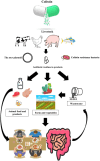Mechanisms in colistin-resistant superbugs transmissible from veterinary, livestock and animal food products to humans
- PMID: 40386099
- PMCID: PMC12085205
- DOI: 10.22099/ijvr.2024.50497.7453
Mechanisms in colistin-resistant superbugs transmissible from veterinary, livestock and animal food products to humans
Abstract
In the era of antibiotic resistance, where multidrug-resistant (MDR), extensively drug resistant (XDR), and pan-drug resistant (PDR) Gram-negative infections are prevalent, it is crucial to identify the primary sources of antibiotic resistance, understand resistant mechanisms, and develop strategies to combat these mechanisms. The emergence of resistance to last-resort antibiotics like colistin has sparked a war between humanity and resistant bacteria, leaving humanity struggling to find effective countermeasures. Although colistin is used as a highly toxic antibiotic in infections that are not treated with routine antibiotics, its widespread use in animal breeding and veterinary medicine has contributed to the spread of colistin-resistant bacteria, plasmid-borne colistin resistance genes (mcr), and antibiotic residues in livestock and animal-derived foods. These sources can potentially transmit colistin resistance to humans through various routes. Therefore, managing the use of colistin in livestock and animal foods, implementing strict monitoring, and establishing guidelines for its proper use are essential to prevent the escalation of colistin resistance. This review article discusses the latest mechanisms of colistin antibiotic resistance, particularly biofilm production as a public health threat, the livestock and animal food sources of this resistance, and the routes of transmission to humans.
Keywords: Animal foods; Colistin resistance; Multidrug-resistant; Veterinary medicine; mcr.
Conflict of interest statement
The authors have no conflicts of interest to declare.
Figures



Similar articles
-
Virulence Determinants and Plasmid-Mediated Colistin Resistance mcr Genes in Gram-Negative Bacteria Isolated From Bovine Milk.Front Cell Infect Microbiol. 2021 Nov 23;11:761417. doi: 10.3389/fcimb.2021.761417. eCollection 2021. Front Cell Infect Microbiol. 2021. PMID: 34888259 Free PMC article.
-
Identification of Novel Mobilized Colistin Resistance Gene mcr-9 in a Multidrug-Resistant, Colistin-Susceptible Salmonella enterica Serotype Typhimurium Isolate.mBio. 2019 May 7;10(3):e00853-19. doi: 10.1128/mBio.00853-19. mBio. 2019. PMID: 31064835 Free PMC article.
-
Resensitizing tigecycline- and colistin-resistant Escherichia coli using an engineered conjugative CRISPR/Cas9 system.Microbiol Spectr. 2024 Apr 2;12(4):e0388423. doi: 10.1128/spectrum.03884-23. Epub 2024 Feb 22. Microbiol Spectr. 2024. PMID: 38385691 Free PMC article.
-
Investigating colistin drug resistance: The role of high-throughput sequencing and bioinformatics.F1000Res. 2019 Feb 4;8:150. doi: 10.12688/f1000research.18081.2. eCollection 2019. F1000Res. 2019. PMID: 31354944 Free PMC article. Review.
-
The Challenge of Global Emergence of Novel Colistin-Resistant Escherichia coli ST131.Microb Drug Resist. 2021 Nov;27(11):1513-1524. doi: 10.1089/mdr.2020.0505. Epub 2021 Apr 28. Microb Drug Resist. 2021. PMID: 33913748 Review.
References
-
- Abuoun, M, Stubberfield, EJ, Duggett, NA, Kirchner, M, Dormer, L, Nunez-Garcia, J, Randall, LP, Lemma, F, Crook, DW, Teale, C. mcr-1 and mcr-2 variant genes identified in Moraxella species isolated from pigs in Great Britain from 2014 to 2015. J. Antimicrob. Chemother. 2017;72:2745–2749. - PMC - PubMed
-
- Barlaam, A, Parisi, A, Spinelli, E, Caruso, M, Taranto, PD, Normanno, G. Global emergence of colistin-resistant Escherichia coli in food chains and associated food safety implications: a review. J. Food Prot. 2019;82:1440–1448. - PubMed
-
- Bastidas-Caldes, C, De Waard, JH, Salgado, MS, Villacís, MJ, Coral-Almeida, M, Yamamoto, Y, Calvopiña, M. Worldwide prevalence of mcr-mediated colistin-resistance Escherichia coli in isolates of clinical samples, healthy humans, and livestock—a systematic review and meta-analysis. Pathogens. 2022;11:659–668. - PMC - PubMed
Publication types
LinkOut - more resources
Full Text Sources
